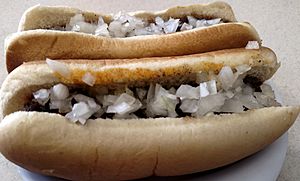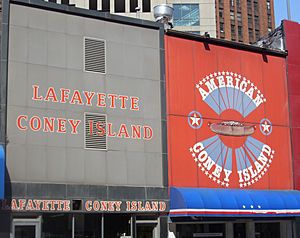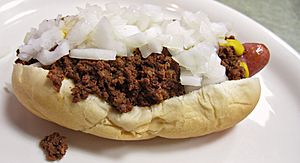Coney Island hot dog facts for kids

A Coney dog
|
|
| Course | Main course |
|---|---|
| Place of origin | United States |
| Region or state | Detroit, Michigan |
| Serving temperature | Hot |
| Main ingredients | Hot dog, or a beef or beef and pork European-style Vienna sausage with lamb or sheep casing, topped with a meat sauce made of seasoned ground beef or beef heart, topped with yellow mustard, white onion and sometimes cheese. |
A Coney Island hot dog (or Coney dog) is a special kind of hot dog. It comes in a bun and is topped with a tasty meat sauce. Sometimes it has other toppings too. You often find Coney dogs at classic American "diner" restaurants. They are especially popular at places called Coney Island restaurants. This yummy food became popular because of people who moved to the United States from Greece and North Macedonia in the early 1900s.
Origin of the Coney Dog
Many different kinds of Coney Island hot dogs were created by Greek or Macedonian immigrants. This happened in the early 1900s. Many of these people came to the US through Ellis Island in New York City. They were often leaving the Balkan Wars.
The name "Coney Island" comes from a Dutch name, Conyne Eylandt. This means Rabbit Island. The English later changed the name to Coney Island in 1664. Hot dogs became famous from this area in Brooklyn, New York. A Polish/Jewish immigrant named Nathan Handwerker was one of the first people to sell them there. His business became "Nathan's". This brand is still very popular today. The name "Coney" for a hot dog likely came from Nathan's growing fame.
Different Kinds of Coney Dogs
Coney dogs have different styles depending on where you are in the United States. Each region adds its own special touch.
Indiana Coney Dogs
The Ft. Wayne's Famous Coney Island Wiener Stand opened in 1914. It was started by three Macedonian immigrants. The Coney dog here is a small, pink hot dog. It has a "peppery-sweet" sauce on a soft bun. The sauce is made from ground beef. It tastes like a mild, savory pork sausage. The hot dog is grilled and put in a steamed bun. Then yellow mustard, chili sauce, and chopped onions are added.
Michigan Coney Dogs
Many people say Detroit is the best place for Coney dogs. People there are very passionate about them. The Michigan Coney Island hot dog uses a special kind of hot dog. It's a natural-casing beef or beef and pork sausage. It's topped with a beef heart-based sauce. Then it gets one or two lines of yellow mustard and diced onions. This style started in the early 1900s. Famous places like American and Lafayette Coney Islands in Detroit started around 1917.
Detroit Style Coney Dogs
In Detroit, many Greek and Macedonian immigrants opened Coney Island restaurants. Later, some Albanian immigrants also started operating them. Greek immigrants started popular chains like Kerby's Koney Island, Leo's Coney Island, and National Coney Island. These chains also sell some Greek food. Detroit style sauce is a chili sauce without beans.
Flint Style Coney Dogs
Flint style Coney dogs have a dry hot dog topping. It's made with ground beef heart. For an "authentic" Flint coney, some say the hot dog must be a Koegel coney. The sauce should be by Angelo's, which opened in 1949. However, the sauce was first made in 1924 by Simion P. (Sam) Brayan. He worked with Koegel Meat Company to make the hot dog they still use today. He also worked with Abbott's Meat for the beef heart sauce base. Restaurants then add their own spices and onions to this base.
Jackson Style Coney Dogs
Jackson style uses a topping of ground beef or ground beef heart. It also has onions and spices. The sauce is usually thick and hearty. This meat sauce goes on a good hot dog in a steamed bun. Then it's topped with diced onions and a line of mustard. Todoroff's restaurants were some of the first places for Jackson coneys, starting in 1914. Now, other places like Jackson Coney Island and Virginia Coney Island are popular. They use ground beef heart for their sauce.
Kalamazoo Style Coney Dogs
Coney Island Kalamazoo opened in 1915. It is the oldest Coney Island restaurant that has been open continuously in Michigan. Their Coney dog has a special topping made from their own recipe. It's served on a Koegel's Skinless Frankfurter.
Coney Dog Suppliers
Some companies provide Coney dogs and sausages to restaurants and people in Michigan:
- Dearborn Sausage Co., a main supplier in Detroit.
- Koegel Meat Company, a main supplier in the Flint area.
Many Coney Island restaurants make their own sauces. But you can also buy different styles of sauces from these companies:
- Abbott's Meat: They make Flint style sauce with ground beef heart.
- National Chili Co., a main supplier in metro Detroit.
- Detroit Chili Company (owned by American Coney Island): They make Detroit style sauce.
Minnesota Coney Dogs
A Greek immigrant named Gus Saites opened his Original Coney Island in Duluth in 1921. They use a hot dog called Vienna Beef from Chicago. It's topped with their own Coney sauce. You can also add mustard, onion, and cheese.
The Original Coney Island Restaurant and Bar in St. Paul has been run by the Arvanitis Family since 1923. It's the oldest business still open in St. Paul, though it's only open for special events now.
Ohio Coney Dogs
In Cincinnati, a "coney" is a hot dog topped with Cincinnati chili. It usually has mustard and chopped onions. A "cheese coney" also has shredded cheddar cheese on top. This dish was created by Macedonian immigrants Tom and John Kardjieff in 1922. They founded Empress Chili. The chili topping is also used on spaghetti. This dish is called a "two-way" or chili spaghetti. In 2013, there were over 250 "chili parlors" in Cincinnati selling coneys. The biggest chains today are Skyline Chili and Gold Star Chili.
Oklahoma Coney Dogs
Coney dogs are popular in restaurants all over Tulsa. They were first made there by Greek immigrants. Oklahoma coneys are small hot dogs on steamed buns. They have a spicy-sweet, dark brown chili sauce, onions, and sometimes cheese and hot sauce. The Coney I-Lander is a well-known place for them.
Texas Coney Dogs
James Coney Island has many locations around Houston, Texas. The company was started in 1923 by two Greek immigrant brothers, James and Tom Papadakis. James is who the company is named after.
Lists
- Cuisine of the Midwestern United States
- List of hot dogs
- List of regional dishes of the United States
Images for kids







